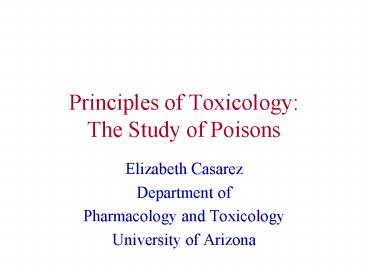Principles of Toxicology: The Study of Poisons - PowerPoint PPT Presentation
1 / 12
Title:
Principles of Toxicology: The Study of Poisons
Description:
Principles of Toxicology: The Study of Poisons Elizabeth Casarez Department of Pharmacology and Toxicology University of Arizona iRespond Graph 67% 33% 100% 100% 67% ... – PowerPoint PPT presentation
Number of Views:110
Avg rating:3.0/5.0
Title: Principles of Toxicology: The Study of Poisons
1
Principles of ToxicologyThe Study of Poisons
- Elizabeth Casarez
- Department of
- Pharmacology and Toxicology
- University of Arizona
2
The study of the adverse effects of a toxicant on
living organisms
- Adverse effects
- any change from an organisms normal state
- dependent upon the concentration of active
compound at the target site for a sufficient
time. - Toxicant (Poison)
- any agent capable of producing a negative
response in a biological system - Living organism
- a sac of water with target sites, storage depots
and enzymes
3
What is a Poison?
- All substances are poisons
- there is none that is not a poison.
- The right dose
- differentiates a poison and a remedy.
- Paracelsus (1493-1541)
4
Dose
- The amount of chemical entering the body
What is a Response? The degree type of
responses depend upon the dose and the
organism--describe exposure conditions with
description of dose
5
How are toxins released into the environment?
- Illegal or improper dumping
- Sub-standard buildings
- Groundwater
- Natural disasters
6
ADMEAbsorption, Distribution, Metabolism, and
Excretion
- Once a living organism has been exposed to a
toxicant, the compound must get into the body and
to its target site in an active form in order to
cause an adverse effect. - The body has defenses
- Membrane barriers
- passive and facilitated diffusion, active
transport - enzymes, antioxidants
- Elimination mechanisms
7
Absorptionability of a chemical to enter the
blood(blood is in equilibrium with tissues)
- Inhalation--readily absorb gases into the blood
stream via the alveoli. (Large alveolar surface,
high blood flow, and proximity of blood to
alveolar air) - Ingestion--absorption through GI tract stomach
(acids), small intestine (long contact time,
large surface area--villi bases and transporters
for others) - Dermal--absorption through epidermis (stratum
corneum), then dermis site and condition of skin
8
Distribution the process in which a chemical
agent translocates throughout the body
- Blood carries the agent to and from its site of
action, storage depots, organs of transformation,
and organs of elimination - Rate of distribution (rapid) dependent upon
- blood flow
- characteristics of toxicant (affinity for the
tissue, and the partition coefficient) - Distribution may change over time
9
Target Organs adverse effect is dependent upon
the concentration of active compound at the
target site for enough time
- Not all organs are affected equally
- greater susceptibility of the target organ
- higher concentration of active compound
- Liver--high blood flow,
- Kidney--high blood flow, concentrates chemicals
- Lung--high blood flow, site of exposure
- Neurons--oxygen dependent, irreversible damage
10
Excretion Toxicants are eliminated from the
body by several routes
- Urinary excretion
- water soluble products are filtered out of the
blood by the kidney and excreted into the urine - Exhalation
- Volatile compounds are exhaled by breathing
- Biliary Excretion via Fecal Excretion
- Compounds can be extracted by the liver and
excreted into the bile. The bile drains into the
small intestine and is eliminated in the feces. - Milk Sweat Saliva
11
Metabolism adverse effect depends on the
concentration of active compound at the target
site over time
- The process by which the administered chemical
(parent compounds) are modified by the organism
by enzymatic reactions. - Key organs in biotransformation
- LIVER (high)
- Lung, Kidney, Intestine (medium)
- Others (low)
12
Individual Susceptibility--there can be 10-30
fold difference in response to a toxicant in a
population
- Genetics-species, strain variation, (yet still
can extrapolate between mammals--similar
biological mechanisms) - Gender
- Age--young (old too)
- underdeveloped excretory mechanisms
- underdeveloped enzymes































